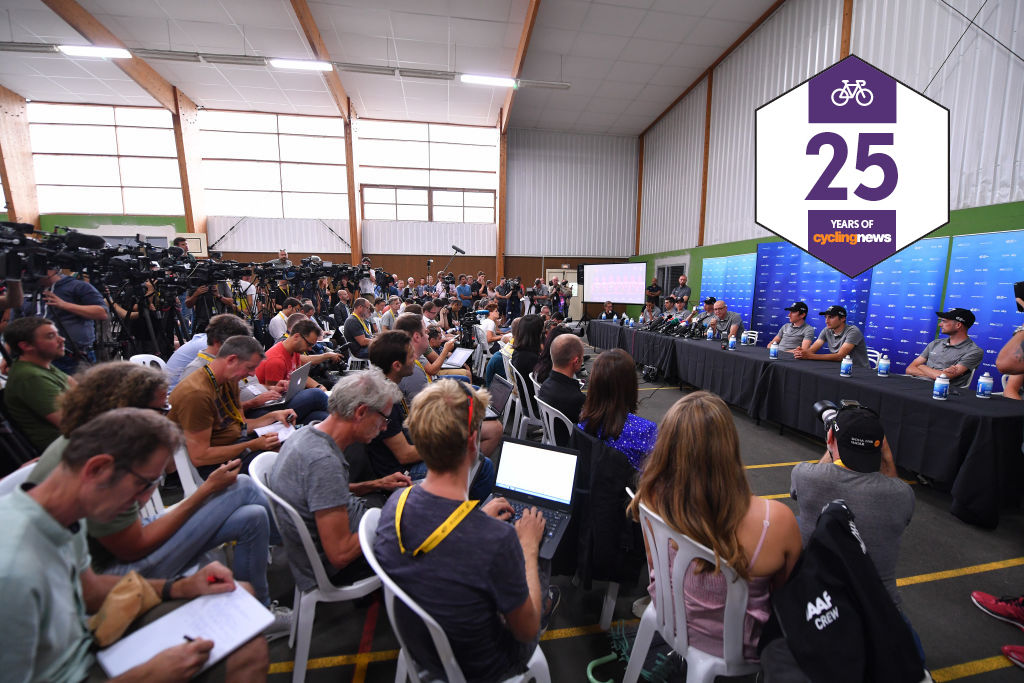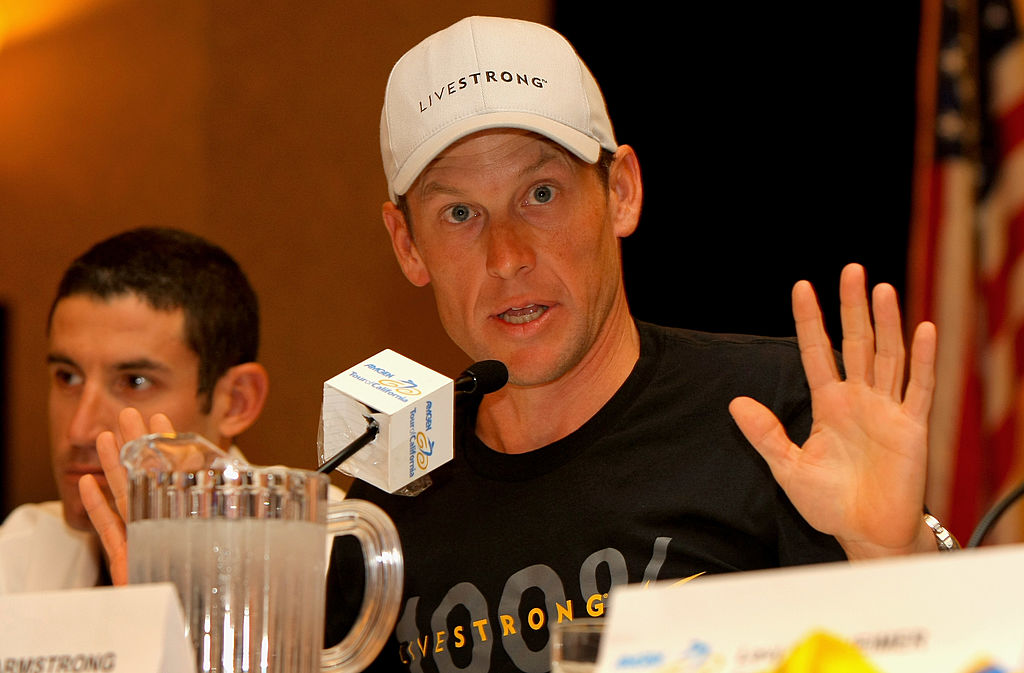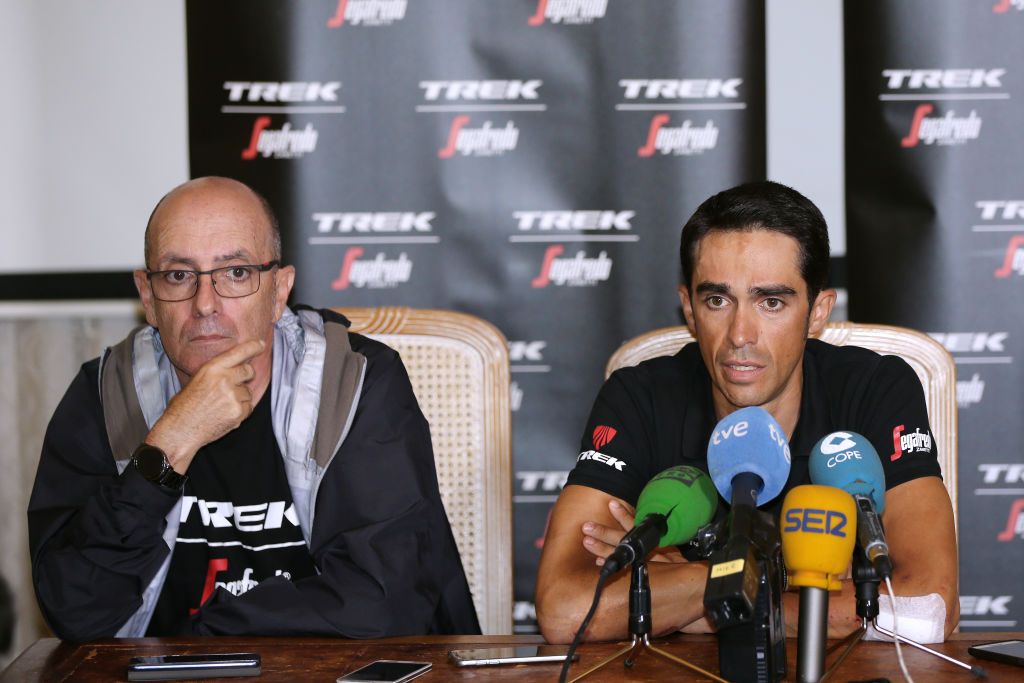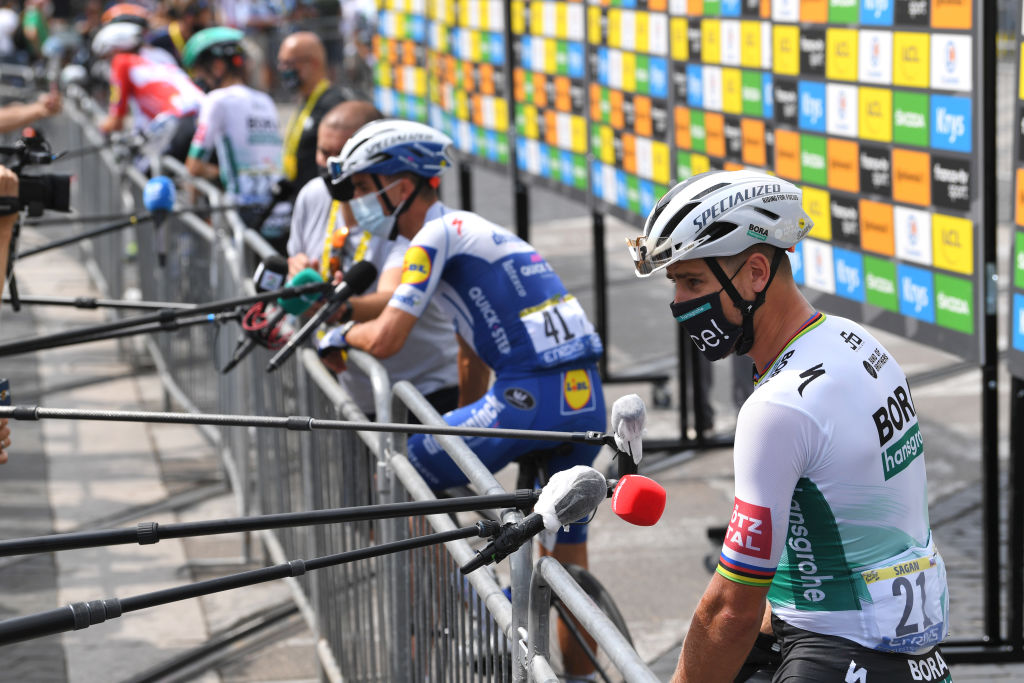How the internet and EPO changed the reporting of professional cycling
Cyclingnews looks back on 25 years of change for the media's coverage of the sport

This year, Cyclingnews celebrates its 25th anniversary, and to mark such an important milestone, the editorial team will be running 25 pieces of work that look back at the sport over the last quarter of a century.
This feature looks at the way the cycling media has changed and how the media's relationship with riders and teams has evolved, from a sense of hatred and omertà during the EPO-fuelled years, to the present day, when social media appears to be so important.
When Cyclingnews first began covering professional cycling in 1995, it marked the start of a new era in how cycling news was produced and consumed. Around the same time, the use and abuse of EPO brought in an incredible new era in performance and racing.
The digital and doping double-whammy meant nothing would ever be the same. The years that followed were filled with police investigations, doping scandals and negative headlines, ending the often-cosy relationship that had long existed between riders and the media.
Fortunately, the sport and the media have changed and evolved multiple times since the Lance Armstrong era and everything it represented. There is a stricter anti-doping strategy in the sport, with far more riders now taking a stand against doping than those ready to resort to it. Most results are now considered believable, with the bad apples gradually expelled from the sport and the former dopers forced to repent if they want to keep their jobs in the sport.
As Cyclingnews celebrates its 25th anniversary, the relationship between the media and the riders and their teams has changed again as a consequence. Most major teams have a number of press officers and spend a chunk of their budget on in-house content, video production and social media. Teams, riders and race organisers are trying harder than ever to control the narrative and spin the news in their favour.
The media is now very much digital first. Cyclingnews is updated constantly, with newspapers and magazines struggling to stay relevant and even alive as we all use our mobile phones for our news and information.
Get The Leadout Newsletter
The latest race content, interviews, features, reviews and expert buying guides, direct to your inbox!
Riders are fitter and faster, and virtually every race can be watched live on a mobile phone and then instantly dissected and debated on Twitter, Instagram, Facebook and elsewhere. Everyone can voice an opinion. At the same time, the riders can reach out directly to fans via social media. Some are even building their own brands and monetising them by selling merchandise and promoting their sponsors' wares. Some teams consider a rider's social media presence as important as their racing results.
Despite all this change, the balance of power remains the same in cycling as it does in the mainstream media; a large part of the public trust and expect the media to report and analyse truthfully what happens at races. Teams, riders and race organisers accept this up to a point, and allow the media better access and closer contact than other major sports, in return for visibility for the sponsors.
A history of access and reporting
The Tour de France, Giro d'Italia, and a number of other races were created in the early 20th century to help sell newspapers, with the heroism and exoticism of the events driving massive sales.
In the glory years of the sport, when print was king, famous journalists followed the race from motorbikes and open-top cars. They spoke to riders post-race in their rooms and then weaved their stories using fact and glorious fiction. Live television emerged in the 1960s and began to dominate in the 1970s, gradually replacing the romanced reporting of the sport. The newspapers and radio stations had a major rival but, fortunately, the quest for news meant the newspapers and specialist magazines thrived.
Journalists used the written word to add the depth television rarely reveals. It was possible to interview riders at home. Every good journalist had a little black book of riders' personal telephone numbers and a close enough relationship to be able to call them whenever needed. Teams didn't have press officers; there didn't really seem any need.
Of course, doping did occur, and was gradually punished more and more, but it was considered by most fans and the media as a lesser evil. The use of EPO changed all that, and changed what filled the sports pages across Europe and the world. So did Bjarne Riis attacking in the big ring on the climb of Hautacam at the 1996 Tour de France, followed by the 1998 Festina Affair, Marco Pantani's disqualification from the 1999 Giro d'Italia, and a constant string of police raids, doping scandals, arrests and suspensions.
Cycling journalists had to learn about haematology and courtroom procedures. Erythropoietin is a very long word, but suddenly everyone in the press room knew how to spell it.
I was in the Bologna courtroom in 2002 when Filippo Simeoni confirmed that he took EPO and growth hormone under the instruction of Dr. Michele Ferrari. In 2004, that testimony led to Armstrong chasing him down and bullying him at the Tour de France.
I covered the hearings for the Reuters news agency, the fee I was paid barely covering my costs. But as the only English-speaking journalist in court, I knew it was important the story came out.
Armstrong's comeback from cancer and his Tour de France victories in the early 2000s were seen by some as a kind of believable fairytale that television, especially, lapped up, and the Texan carefully used that to his benefit. Most riders and teams were living a lie, and so an omertà fell across the peloton, with riders keen to protect their newfound success, their bigger salaries and even their fellow riders.

They closed ranks, and it was difficult to secure real evidence of what was going on behind the love of big gears and certain sports doctors. The Spanish Once team were the first to introduce team buses, and the other teams soon followed; the tinted windows and curtains offered privacy from prying eyes and probing questions. Riders saw the media as their enemy more than ever before, while the fans and the media were divided between those wanting a clean sport and those with a more laissez-faire attitude.
Parts of the cycling media preferred to focus on the racing, but police investigations and the reporting of Paul Kimmage, David Walsh and Pierre Ballester and the brave public revelations of Betsy and Frankie Andreu, Emma O'Reilly, Stephen Swart and Greg Lemond eventually meant doping was too much of a problem to ignore.
In response some teams created black lists of media that their riders should avoid talking to. Armstrong used access as a way of filtering out his enemies. If you wrote about doping, and especially if you wrote about Armstrong and doping, you never got an invitation to his select round-table press conferences and missed the story of the day.
I covered several of Armstrong’s Tours for Reuters and was sent to chase after him at stage finishes to capture whatever he said and try to question him. One day he snubbed both Reuters and the Associated Press for one of his invite-only round table interviews. We pressured his entourage and team for several days to give us some access and he eventually agreed. However, Armstrong always tried to dominate and control the media as much as he did with his rivals out on the road.
Other riders and teams imitated his tactics and began to hire more press officers and even bodyguards, and more filters and walls were added. Doping questions were seen as offensive and out of place.
One rider who loved to go on the attack thought he had the right to openly criticise journalists asking his teammates about doping. Sadly, nobody in his team or the press corps told him to shut up. Anyone who spoke out – like the riders Christophe Bassons, Erwann Menthéour and Filippo Simeoni – were treated like pariahs rather than role models.
Race organisers and the UCI did little to rock the boat. The sport somehow rolled on, but the scandals continued: Operación Puerto caught Jan Ullrich, Ivan Basso and others. Floyd Landis tested positive in 2006 and Riccardo Riccò was arrested for doping during the 2008 Tour after testing positive for EPO variant CERA. Professional cycling had become something of a joke at this point, its credibility often derided and compared to that of wrestling or boxing.
The house of cards eventually tumbled when Landis sparked the USADA investigation into Armstrong and eventually his confession in 2013. It was the end of an era. Since then, the scandals have decreased, the performances have become more human and more believable. Many people accept that doping will never be eradicated, but professional cycling has gradually regained some credibility.
Doping is still possible, and there are still holes in the UCI's biological passport programme, but the risks are higher and the rewards fewer. Clean riders and teams seem to have built an ever-more influential majority, even if it sadly remains mostly silent.
After coming back from his own doping ban, British rider David Millar suggested that it would take a generation to change the sport. He appears to be right but, fortunately, a new, more open and engaging generation of riders is emerging and slowly taking over.
Staying on message
Sadly, teams still want to try to control the media, even if they have far less to hide. Now it's about staying on message to keep their sponsors happy. Team Sky brought a strict and controlled corporate message into the sport in 2010 and virtually everyone has copied them as if it was a magical marginal gain.
These days, when a rider thanks their team for helping them win, they don't always mean it, but are just repeating the lines that have been drilled into them during media training. Some riders are friendly, emotive and spontaneous, but others seem like robots – happy to repeat the company line as a way to dodge the pressure and expectation.
When you spend time with the riders, especially at training camps or early season races where there are no team buses, and it is easy to see that most are decent human beings, each with a fascinating story to tell.
Yet some just don’t seem interested in opening up and revealing their true emotions. Primož Roglič is a good example. I’ve seen him make jokes with teammates and other riders and he seems well liked by most people in the peloton. His wife Lore often visits him at races and they share a kiss and a moment of affection before and after races. Yet Roglič is very guarded with the media. I’ve spent hours waiting for him outside the Jumbo-Visma team bus only for him to give a few monosyllabic answers. He seems a superb athlete and is fascinating to observe in both victory and defeat. I just wish he would share his emotions and thoughts with us all.

Teams now have a squad of press officers, someone else to write their press releases and update their website, and others to make numerous social media posts. Interview opportunities are controlled and open press conferences are rare, especially at major races like the Tour de France.
Some teams measure their success through the reach of their social media. For others, the number of victories in a season is still considered more important than the way they are won. Often, defeat is seen as something to be ashamed of, and teams often shut their riders in the bus, hiding away the emotions of the sport.
Fortunately, some riders love to talk and wear their hearts on their sleeves. France's Julian Alaphilippe talked to the written press for more than 30 minutes after winning the World Championships road race this year, 2018 Tour de France winner Geraint Thomas always speaks his mind, Dutchman Tom Dumoulin is articulate and honest, and Frenchman Thibaut Pinot never hides his emotions.
The media understand that riders are caught up in their own world of racing, training and fatigue and so it is a pleasant surprise when Richie Porte makes an effort to ask how you are before an interview, a directeur sportif offers you a ride down from a mountain finish or a coffee from the team bus.
They are all proof that a good working relationship are possible, especially now as the peloton has less to hide.
The new limitations of the COVID-19 season
Sadly, the COVID-19 pandemic has significantly limited the work of the media in 2020. It was a special season, with the Grand Tours in September, October and November, and the Classics in autumn instead of spring. We witnessed some thrilling racing and dramatic endings, but there was little depth and understanding – a lack of emotion and explanation.
Cyclingnews usually has a journalist on the ground at most major races on the calendar, from the Tour Down Under until Il Lombardia. We believe it is a vital part of providing the best possible coverage of the races. However, health concerns and COVID-19 restrictions meant we limited our presence to the Grand Tours and the World Championships.

To protect the rider and race COVID-19 bubbles, the written press was not generally allowed at race finishes. Media was not allowed near the team buses, and post-race video press conferences were often short and cold. Access was limited and controlled, with teams preferring to send sound files via WhatsApp groups. In-person interviews were limited to an open-air mixed zone, which riders and teams could choose to bypass at will. The media had to use boom microphones and shout questions across a two-metre safe distance, all while wearing masks.
Instead of being a moment to capture riders' emotions immediately after they had crossed the finish line, when they had won or lost, the mixed zone was akin to that of football coverage: lifeless and largely unentertaining, no matter how hard the journalists and riders tried to make it work. If the riders seem to lack character and emotion this year, that is the reason why.
Fortunately, most riders no longer seem to see the media as the enemy, and appear to have nothing to hide. They know they have stories to tell and want to share them. Hopefully, Cyclingnews will be able to tell them in 2021.

Stephen is one of the most experienced member of the Cyclingnews team, having reported on professional cycling since 1994. He has been Head of News at Cyclingnews since 2022, before which he held the position of European editor since 2012 and previously worked for Reuters, Shift Active Media, and CyclingWeekly, among other publications.